You have a list of topics and keywords in your content strategy.
But, how do you create high-quality blog posts with business value that get the results?
These types of results include:
- Ranking first page of Google
- Attracting qualified traffic
- User acquisition
The short answer is to match the search intent and meet the underlying motive behind each search. Even if you’re up against websites with more authority, it doesn’t stop you from writing better quality content.
That was the gap I had to fill when I worked with Enhancv.
Note: This case study guide was first published in 2021 but has been updated in 2022.
Table of Contents
Context About The Situation
Enhancv is an online resume creator that helps job seekers create a modern, professional job application.
You could imagine the amount of questions people search on Google related to:
- Career development
- Interview tips
- Resume advice
They already had an SEO and content strategy in place but were looking to execute high-quality pieces for each topic. In other words, to scale the marketing strategy by investing in content that’s invaluable to their audience.
The Reader-Centred Approach
The reader-centric approach ensures you’re creating content that resonates.
While it’s good to have objectives, it’s equally important to reverse-engineer them to find out exactly what you need to do. The same applies to creating content that resonates with your reader – it’s the basis for solving a real problem and giving value that’s tailored for your audience.
4 Simple Steps I Used to Create SEO Content for Enhancv
1. Define the Specific Type of Person You’re Writing For
When defining your readers, it means knowing who you’re writing to by having an understanding of their background. This includes information such as:
- Pain points
- Goals
- Motivations
- Preferences
- Social media hangout
A blog post that qualifies as a good piece of content puts the needs of your readers first. That means giving them the answers they’re looking for to overcome a problem and get one step closer to achieving a goal.
Without knowing what makes them tick, it’s difficult to give the type of value that strikes a chord.
And without giving that type of tailored value, it’s unlikely you’ll reach them on a profound level.
2. Understand the Search Intent
Every topic can be looked at and told from different angles.
Those angles are through the lenses of specific search intents and pain points. It’s more than just knowing whether the query is navigational or commercial.
Defining the search intent means knowing:
- Questions the reader has about the topic
- The type of answers they’re looking for
- Problems they’re trying to solve
- A desirable end goal or result
In other words, all the subtopics and concepts that are relevant to the searcher’s query need to be covered substantially in your article.
The SEO and content manager of Enhancv, Kaloyan Dimitrov, also mentions that:
“You want your readers to be satisfied with the content on your pages – that’s your primary objective as a content marketer. Identifying the search intent for each content topic you’re working on is your first and most important step of the content writing process. Fail that, and you will be struggling to get any organic visibility through search engines”
Even though keyword research and competitor analysis are important, your readers and the search intent always come first.
3. Content Creation
Now that we’ve done the research, it’s time to start writing. The process includes 3 stages:
- Outline
- Draft
- Edit
Outlining is where you write a layout of the information and points you’re going to cover. It’s also a way for you to brain dump your ideas so you have a clear roadmap of what to talk about. This helps with articulating your thoughts and being able to better present the narrative.
After making a full outline, you draft those ideas into sentences and paragraphs. However, don’t spend too much time trying to perfect each sentence.
“The purpose of the first draft is not to get it right, but to get it written”
John Dufresne
The editing process is where you polish your writing and get it right. This includes checking for the following:
- Format
- SEO optimization
- Reading level
- Writing tone
- Typos
4. Repeat
After completing the 3 steps, you’re ready to hit publish and start promoting the blog post.
Once that’s done, you repeat the process for the next topics you have listed. Slowly but surely, the growth compounds over time and the results of your work will start to show.
Keep in mind that SEO takes time. It’s not something where you see results overnight.
Plus, there are more factors than the writing itself when aiming to rank higher on the search engines. These things include:
- Technical SEO
- Off-page SEO
- Backlinks
- Content promotion
Unless you’re already an industry leader, it can take months and years to build a well-established reputation. But unlike paid advertising, once you’ve earned the spot the rewards will continuously pay off.
That’s what makes SEO worthwhile to pursue.
The Fruits of Our Labour
After 4 months of consistent publishing and content creation, we’ve brought in 128,071 new visitors to the website.
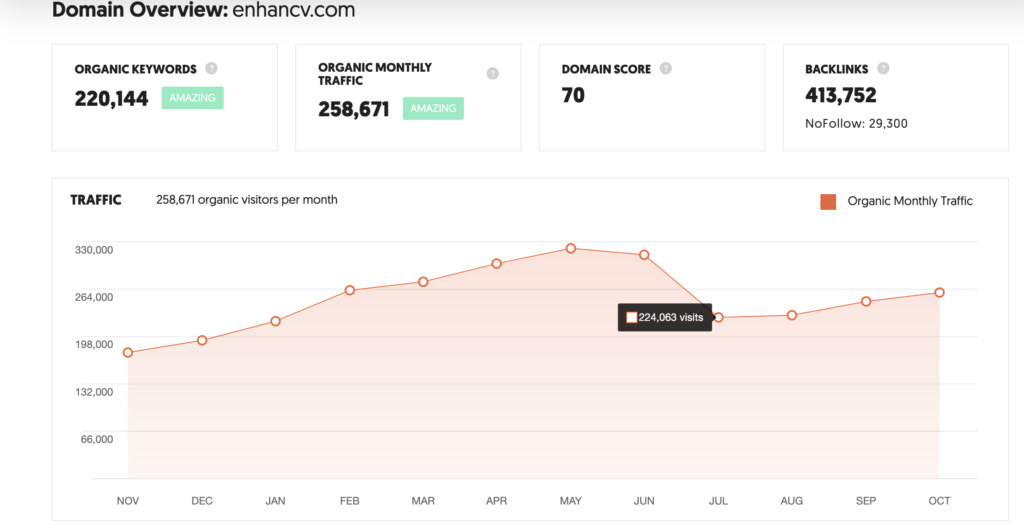
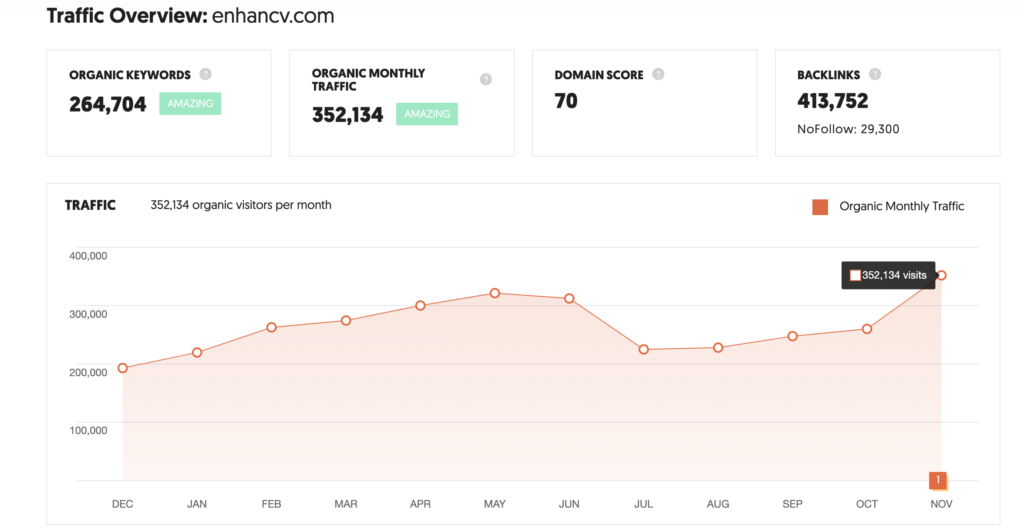
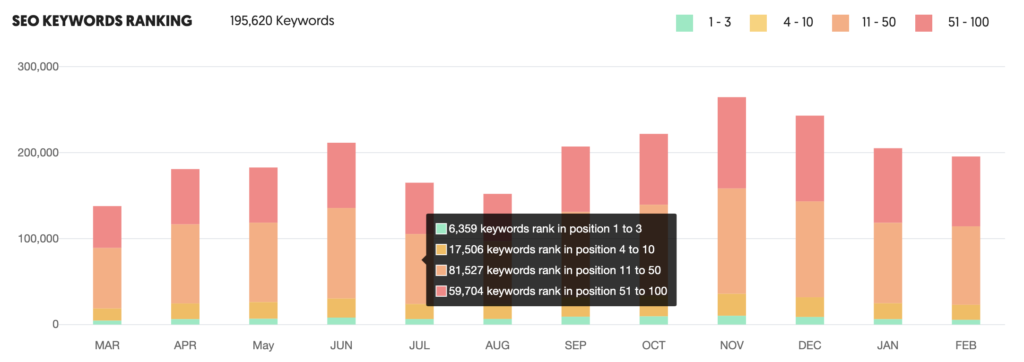
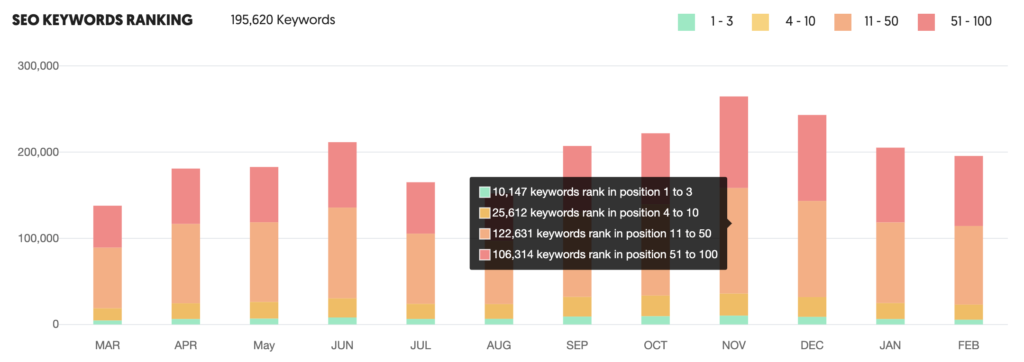
Jump forward to 1 year later, the Google algorithm had a negative impact on our website amongst many others. But they were still bringing in unique visitors.
Throughout the SEO journey, you’ll find the search traffic fluctuating from time to time, which is a normal part of the process.
The more important statistic is whether or not you’re acquiring new users. Using Amplitude (a visual analytics software), it revealed that around 6% of all readers created an account with Enhancv from the blog posts alone that I had created.
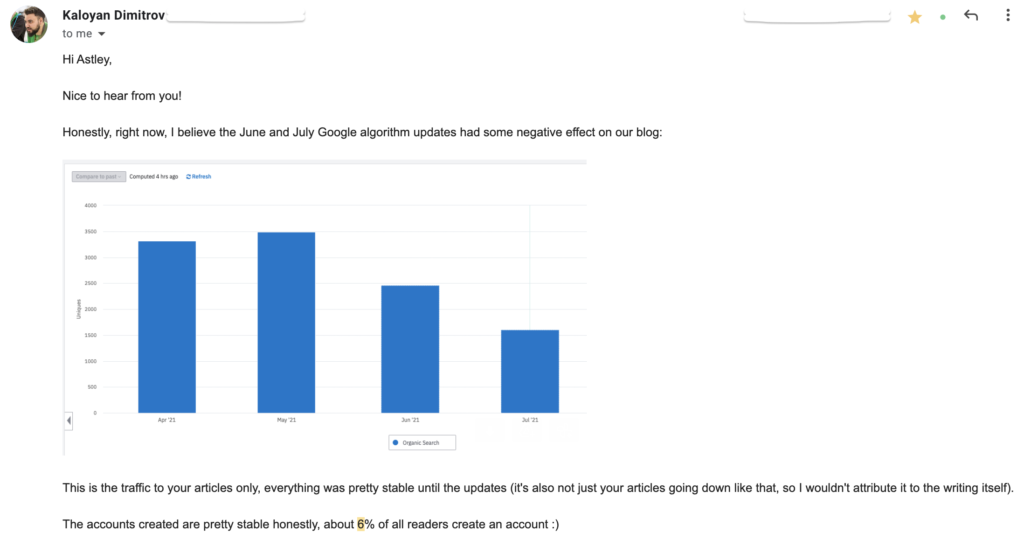
Bonus Step 5: Update Old Pieces of Content
A bonus step is to identify old pieces of content that can be updated or repurposed.
These include:
- Top-performing articles
- Blogs ranking page 2 of Google
- Outdated content
If you have pages on your website with no links pointing to them (orphan pages), these should either be updated or removed. It’s harmful to both SEO and the user experience because they can’t be reached. Therefore, it’s unlikely that they’ll be indexed by Google.
The Result of Updating Old Blog Posts
Once we’ve identified the old pieces of content to update and optimize, we began to see some traction after publishing them to the blog.
Some began to rank on page 1 of Google and started to ramp up in traffic.
Here’s a screenshot of the results achieved by updating the old pieces of content.
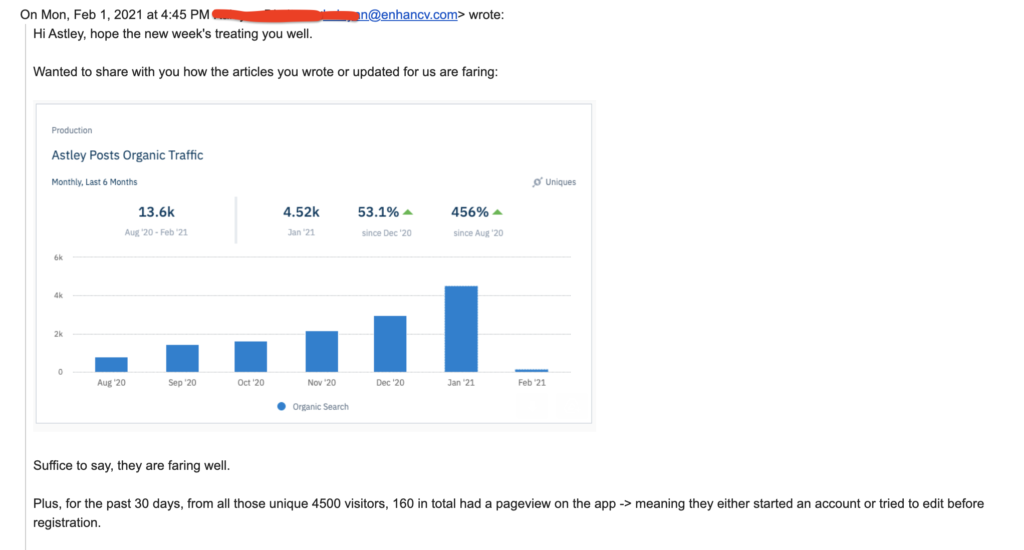
The month of January shows a significant increase in unique visitors landing on the website.
However, the number of traffic doesn’t mean much if it doesn’t lead to any sort of action. So a key aspect to look at is what came out of those people who visited the website.
According to the data, 160 in total had a pageview on the app.
This meant that 3.5% of visitors either signed up for an account or tried to use the product.
Jump forward a month later to February, here’s how things progressed.
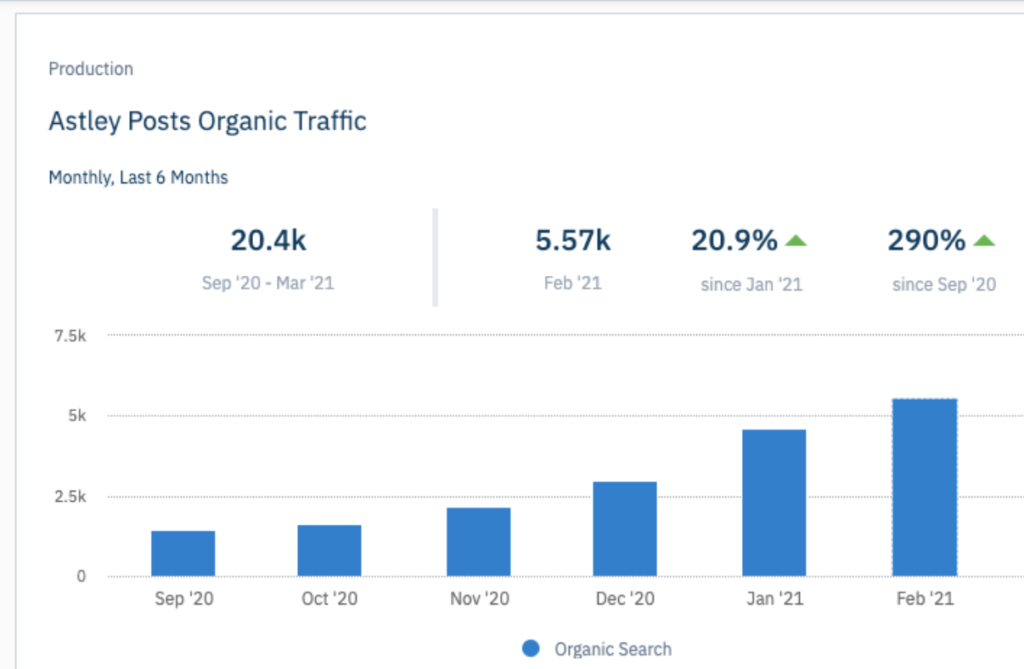
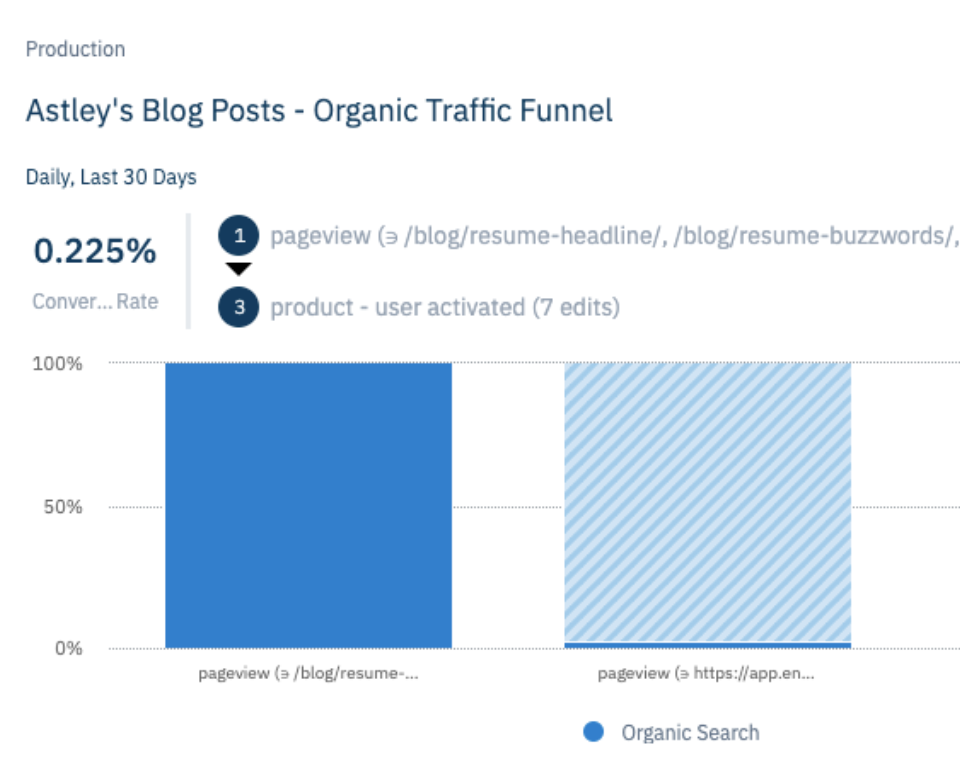
Based on the blog posts I had updated and excluding the landing pages, it led to:
- Organic traffic of 5,570.
- 118 user signups
- 10 active users

Passive YoY Growth

3 Key Elements In My Approach
So far, we’ve looked at the general framework I used to create SEO content that drives results.
But I haven’t quite gone through some of the main elements that have played a major role in my work.
Even after following all the steps above such as defining your readers, there are a few more layers I breakthrough to take it a step further.
Product-Led Storytelling
Product-led storytelling means using your product’s solution as a guiding principle.
To put it another way, it’s showcasing how your product solves a problem and how it’s going to help your reader achieve a goal or overcome an obstacle.
When you showcase a practical step using your product to solve their problem, it does 2 things:
- Provokes the reader to take action.
- Builds brand reputation and awareness.
Depending on the search intent, there’s a good chance the searcher is looking for an actionable solution to their query. That’s what makes product-led storytelling effective for driving user acquisition, signups, and getting leads from your content.
Product-Led Storytelling Example
Let’s take a look at an example with one of the articles I wrote for Enhancv.
As I’ve mentioned, it starts off with a SERP analysis to unveil the search intent and to find the core sections of what we need to cover. From what’s on the first page, most of our competitors have covered the topic in detail with great depth.
But what they haven’t included is a demonstration of how their product works to solve the problem behind their query.
Aside from driving user signups, it was another way to make our SEO content stand out.




It’s very straightforward. All I simply did was use screenshots and a step-by-step process to guide the reader.
This approach is similar to what a lot of marketing software blogs do when explaining how to do something, e.g. Ahrefs, Ubersuggest, SEMrush, Mangools, etc.
The Hidden Search Intent
The hidden search intent is more than just identifying the desired end result, the obstacle they’re trying to overcome, or the bigger picture.
It means knowing the root need behind their search and where it stems from.
To put it simply, cut through to the heart of the matter. The deeper you go into your audience’s needs, the better. So, ask yourself:
- What is the underlying motive beneath each search related to the main topic?
- Where does the problem they’re trying to solve come from?
- How can I give them the information they’re looking for?
- Are there any details you could include that would make their life easier?
This helps you come up with more interesting and unique points to stand out from the other articles on Google.
And really, it’s where the art of writing shines. Here’s my input:
“As a writer, we need to use our creative ability to step into the lens of our reader, see what the world is like from their perspective, and express novelty ideas in their language. At the same time, it comes together with the scientific aspect of marketing. So as a marketer, we have to refine that creativity by putting the pieces together into a logical narrative that resonates best with your audience.”
The Hidden Search Intent Example
In one of the articles I created, the first thing I did was a SERP analysis and a review of the other blog posts we wanted to outrank.
Not to copy them and just cover the same things they did in more depth. But to see what they’ve talked about and if there are any gaps or openings hinted from subtle details.
In this case, here’s what was on the first page of Google.


Before I was assigned to this piece of content, it was ranked on the second page of Google. After updating and re-publishing it, the rankings moved up to the first page.
Based on the titles and meta descriptions, I concluded that there are links to the idea of whether or not you should use a reverse chronological resume. This was a specific angle most articles haven’t covered in great detail, and that was our opening.
Yes, searchers want to know what this type of resume is, how it works, and how to create one.
But the underlying, hidden intent (drawn from my analysis) is whether or not this format is the best option for their next job application.
So in this article, I targeted that angle specifically while also covering all the essential subtopics in detail. You can immediately see from the headline of our blog post that it takes on a different approach, which makes us stand out.
Meetings and Strategy Sessions
These were mostly proactive consultations where I share ideas and feedback to improve the overall content performance. For example:
- Distribution techniques
- Marketing strategies
- SEO advice
I also walked through some of my thought processes and frameworks. I’m always open to feedback and suggestions.
As we bounced off each other’s ideas, it was great for both creativity and finding new insights to make Enhancv’s content even better as a whole. Since you’re working with a third-party member, it gives you a fresh perspective of your business.
However, if everything can be summarized into a single email, then a meeting won’t be necessary.
Get Results Like Enhancv
Would you like similar results to Enhancv?
I might not have the same skills as Seth Godin. But what I do have up my sleeve is the ability to help small businesses with their content marketing and SEO to refine your blog into a sustainable channel for organic growth.
Working with me means catering to user and topic research carefully.
If you’re looking to:
- Hire not just a writer, but a content marketer with SEO expertise
- Create valuable content that drives qualified traffic and user signups
- Build demand and stand out from your competitors
Then, I’d love to have a chat to see how I could help. Please get in touch with me at astley@minimalist-copy.com.

Thank you! I’m happy to hear that 🙂
First time here, wish you good!
Thank you!